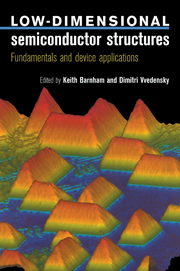Book contents
- Frontmatter
- Contents
- List of contributors
- Preface
- 1 Epitaxial Growth of Semiconductors
- 2 Electrons in Quantum Semiconductor Structures: An Introduction
- 3 Electrons in Quantum Semiconductors Structures: More Advanced Systems and Methods
- 4 Phonons in Low-dimensional Semiconductor Structures
- 5 Localization and Quantum Transport
- 6 Electronic States and Optical Properties of Quantum Wells
- 7 Non-Linear Optics in Low-dimensional Semiconductors
- 8 Semiconductor Lasers
- 9 Mesoscopic Devices
- 10 High-speed Heterostructure Devices
- Solutions to Selected Exercises
- Index
5 - Localization and Quantum Transport
Published online by Cambridge University Press: 06 July 2010
- Frontmatter
- Contents
- List of contributors
- Preface
- 1 Epitaxial Growth of Semiconductors
- 2 Electrons in Quantum Semiconductor Structures: An Introduction
- 3 Electrons in Quantum Semiconductors Structures: More Advanced Systems and Methods
- 4 Phonons in Low-dimensional Semiconductor Structures
- 5 Localization and Quantum Transport
- 6 Electronic States and Optical Properties of Quantum Wells
- 7 Non-Linear Optics in Low-dimensional Semiconductors
- 8 Semiconductor Lasers
- 9 Mesoscopic Devices
- 10 High-speed Heterostructure Devices
- Solutions to Selected Exercises
- Index
Summary
Introduction
Traditional solid-state physics is based on the concept of the perfect crystalline solid, sometimes with a relatively low density of defects. This perfect crystallinity has played a crucial role in the development of the subject, with Bloch's theorem providing the central conceptual base. Concepts that arise from this theorem, such as bands, Brillouin zones, vertical transitions, effective mass and heavy and light holes, are really only well-defined in a perfect infinite crystal. In the absence of crystallinity none of these concepts is strictly valid, though in some cases it provides a useful starting point. In general, however, a new approach is required to characterize electrons and phonons in disordered solids.
When we consider low-dimensional structures Bloch's theorem may or may not be valid. There is nothing intrinsic to low dimensionality which invalidates it. Many of the simple examples in quantum mechanics and solid-state physics textbooks are, in fact, one-dimensional (e.g. the particle in a box, the Kronig–Penney model). Indeed, in a quantum well prepared by any of the standard growth methods (Chapter 1), much of the physics can be understood by using first-year undergraduate quantum mechanics and the effective mass approximation (Chapter 2). This is because a region of adjacent GaAs layers in AlxGa1−xAs can, for many purposes, be regarded as a perfect potential well. By doping the AlGaAs, the electrons in the well can be spatially separated from the scattering due to the ionized donor atoms (Chapter 3).
- Type
- Chapter
- Information
- Low-Dimensional Semiconductor StructuresFundamentals and Device Applications, pp. 149 - 179Publisher: Cambridge University PressPrint publication year: 2001
- 1
- Cited by



